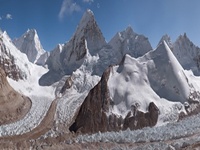Everest glaciers shrinking, hitting Asia’s big rivers: experts
18 May 2013
The global thaw is increasingly affecting Mount Everest, the world's tallest peak, researchers said at the American Geophysical Union meeting in Cancún, Mexico this week.
 Glaciers in the Everest region have shrunk by 13 per cent in the last 50 years and the snowline has shifted upward by 180 metres, Sudeep Thakuri, a graduate student at the University of Milan in Italy, said in a statement.
Glaciers in the Everest region have shrunk by 13 per cent in the last 50 years and the snowline has shifted upward by 180 metres, Sudeep Thakuri, a graduate student at the University of Milan in Italy, said in a statement.
Located in the Himalaya Mountains on the border between China and Nepal, the summit of Everest (now more correctly referred to by its Tibetan name Chomolungma) is 29,029 feet (8,848 m) above sea level.
Thakuri and his colleagues tracked changes to glaciers, temperatures and precipitation at Everest and the surrounding Sagarmatha National Park. There, glaciers have retreated by 1,300 feet (400 m) since 1962, the team found.
More recently, precipitation (both snow and rain) has dropped by100 mm and temperatures have risen 0.6 degrees Celsius since 1992.
The researchers suspect that the glacial melting in the Everest region is due to global warming, but they have not yet established a firm connection between the mountains' changes and climate change, Thakuri said in the statement.
While Everest isn't the only Himalayan region seeing the effects of climate change, not all of the region's glaciers are melting. The snowline in the Karakoram Mountains on the China-India-Pakistan border (where the world's second-highest peak K2 lies) are holding steady and may even be growing.
But shrinking glaciers in the rest of the Himalayas have drawn significant global attention, because the glaciers provide water and power for roughly 1.5 billion people.
Snowlines in the Everest national park region have shifted upslope some 180 metres, Thakuri said.
"The temperature trend shows that temperature has increased in pre-monsoon months, which can cause rapid melting of glaciers in the pre-monsoon, and also in winter months, which can [reduce] snow accumulation," he said.
About 87 per cent of the precipitation above 5,000 metres occurs during the four-month monsoon season, and this has decreased, he said.
While the glacier loss could reshape the famous face of the world's highest peak, a far larger and more serious issue accompanies glacier loss across the Himalaya.
The towering ranges surrounding the Tibetan Plateau give rise to many of Asia's great rivers, including the Ganges and the Jamuna, the Yangtze Kang, the Yellow River, and Mekong. These rivers provide critical water for as many as two billion people - almost a third of earth's population.
If those water sources become less reliable, downstream impacts could become very serious indeed, Thakuri said.
While Thakuri and his co-authors suspect that greenhouse gas-driven global warming is a factor in the Everest meltdown, he cautioned that their data have not established a firm link between the two.
The findings come as no surprise to the climbing community, noted Conrad Anker, one of the world's most accomplished mountaineers and a veteran of numerous Chomolungma expeditions.
The ice line seems to have moved up significantly since his first trip up the mountain, Anker said. In 2012 he was part of a West Ridge climb to commemorate the 1963 American Mount Everest Expedition.
"The conditions were so difficult," Anker said. "It had just melted out up there. The Hornbein Couloir was blue ice, and while it's hard to say too much from studying photographs, back in 1963 they were stomping up snow slopes there.
"And the last eight years in the Central Himalaya have been especially dry. Is it warmer temperatures, or less snow, or some combination? I don't know, but it's just melting out up there."
Small glaciers appear to be melting most quickly, according to Thakuri, a resident of Nepal's Kathmandu Valley.
Those glaciers smaller than about a square kilometre have shrank in surface area by 43 per cent since the 1960s, while their boundaries have retreated upslope some 400 metres during that time.
Anker has seen changes firsthand in the wider Everest region as well.
"When we climbed Cho Oyo, the world's sixth-highest peak, in 2005, we were rock climbing where my good friend Galen Rowell had been ice climbing back in 1985 or 1986. And it was newly exposed rock, rock that had been under ice for a very long time and wasn't weathered at all," he said.







.webp)














